|
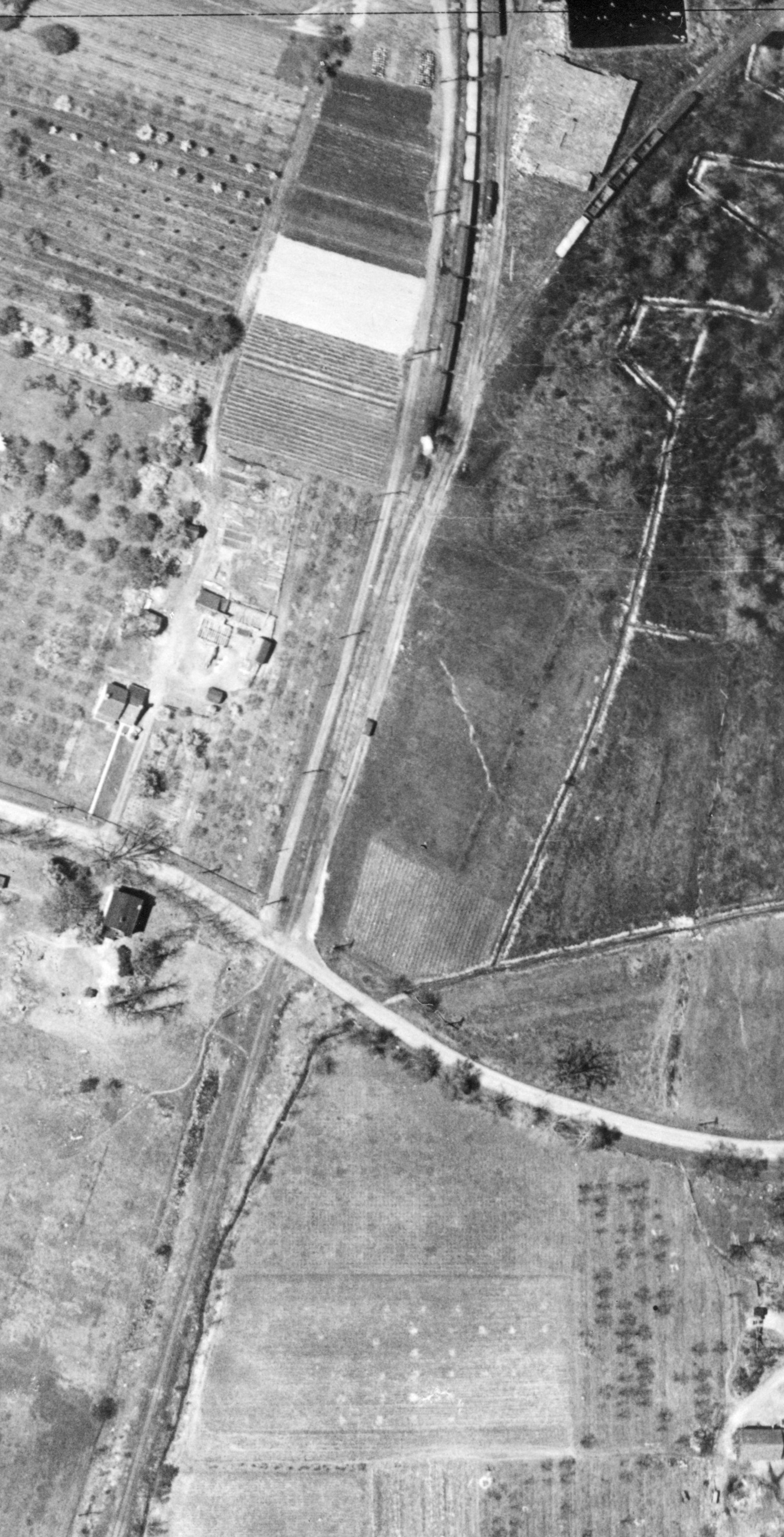 |
| This 1923 aerial
view shows an RV train, probably with #11 steaming,
switching the Wright Chemical Company on the wye at
Branch Junction in Union. The road cutting across the
image is Chester Road, much later the busy Route 22.
Union Township Historical
Society. | |
“Even World War I failed to help
stabilize the little Rahway, although business picked up
considerably" (
Cunningham 38
). The Rahway Valley
Railroad spiraled into a cataclysmic nose-dive in the years
immediately after World War I. War time plants reduced production,
changed output, closed down, or left the area altogether. Activity
along the rails of the RV went from boom to bust literally
overnight. “No one knows just how the road got through the tough
years that followed” (Young).
"Hardly had the management finished searching
their safe with candles to see if there might possibly be something
left in it when the famous ice storm of the winter of 1918-1919
struck in with devastating effects” (Young).
The lack of business being done along t
he line set the railroad up for a record setting
deficit in 1920, expenses eclipsed revenues by more than $50,000.
James S. Caldwell, the railroad’s General Manager,
and Andrew A. Lockwood, the railroad’s Auditor,
attempted to straighten out the railroad’s books but it continued to
sink further into debt with each succeeding year. “All through
the Twenties little kept the line going save its score of fuel and
lumber yards. Outside income consisted of infrequent Jersey Central
specials which crept over the uncertain trackage . . .”
(Young).
The Elmira interests who
held the majority of the railroad’s debt looked to rid themselves of
the financial monstrosity. Matthias H. Arnot and
Ray Tompkins, the railroad’s primary creditors, had both passed
away and the representatives of their estates moved to liquidate,
and even offered the property for sale. Louis Keller purchased the
majority of the bonds and shares that the Arnot and Tompkins estates
held in the RV in 1921. Keller continued to fund the railroad’s
operation year to year with his own personal finances.
“Meanwhile the
automobile had made its entrance upon the American scene. Improved
roads had begun to erode railroad passenger service, until in 1919;
all daily passenger service was terminated. Occasionally, the Rahway
Valley ran a mixed train, the passenger coach coupled to the end of
the freight to Summit, to keep the State Franchise alive" (McCoy
14
). Passenger service, which had a banner year of bringing in
$10,690 for the railroad in 1918, only accrued $4,920 for the RV in
1919. “In the spring of 1919, Keller ditched the three faithful
coaches, for another motor car, passenger days were surely almost
over” (Young). The Rahway Valley Railroad operated mixed trains, as
well as its one railbus, possibly until as late as 1925. There were
also the labor trains that travelled over the Rahway Valley Line to
Maplewood (a.k.a. Newark Heights), “. . . there was little else of note save for
“worker’s trains” on the Heights Branch. They consisted of the
regular freight bedecked with men going to work, in the cab, on the
tops of cars, and on the pilot" (Young).
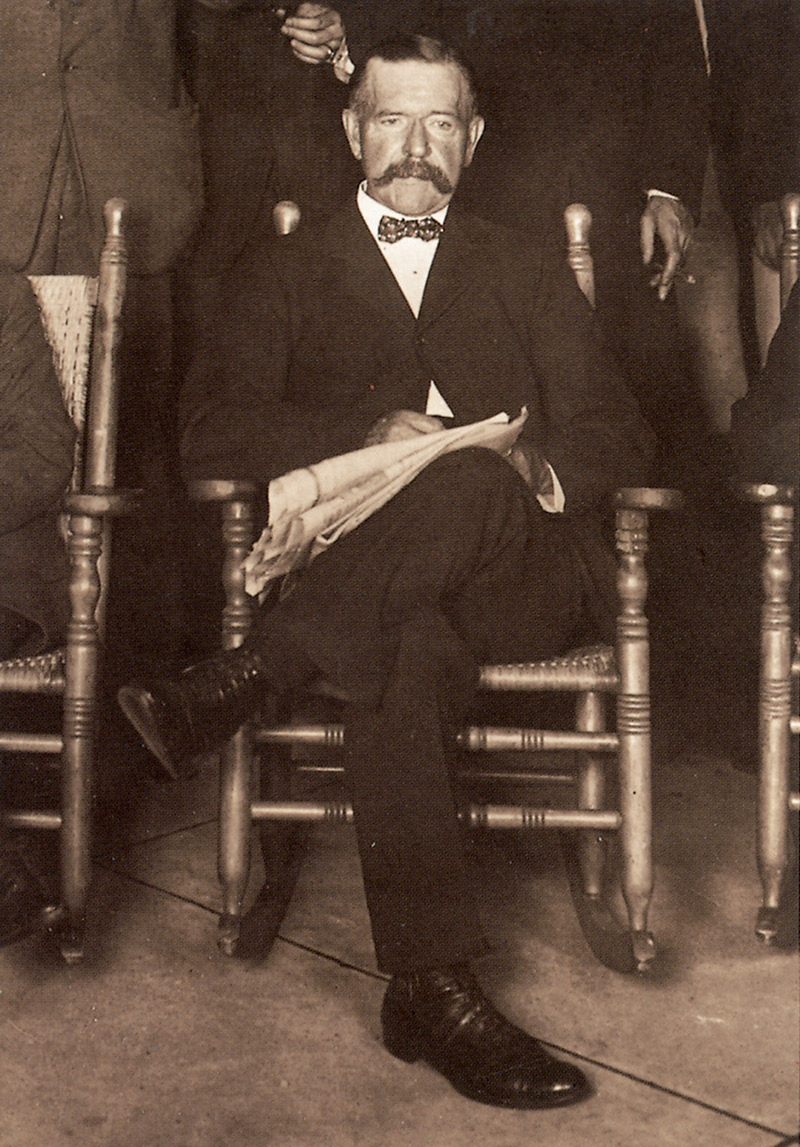 |
| Louis Keller,
seen in his later years. Shortly before his death,
Keller acquired controlling interest in the RV from the
Elmira interests that held the majority of the
railroad's debt. Baltusrol Golf
Club. | |
Regarding
RV passenger service, a bizarre news article appeared in a 1920
issue of The Evening Telegram. The article told that the RV
had acquired four jitney buses which it would convert for rail use.
“ With the business
daring of a Jim Hill the Rahway Valley Railroad, which operates the
only “true” freight line between the Grand Canyon of Kenilworth and
the willow-kissed waters of the limpid Rahway River, today hurried a
defi at the Public Service Railway Company which bids fair to put
the skids under the traction company’s anti-jitney drive. The valley
road announced that is come by four pneumatic tired jitneys, each
with a thirty-five passenger capacity, and just as soon as the road
can replace the rubber with steel shoes and cut the wheels to the
measure of the rails there will be inaugurated the first and only
jitney railroad this side of the Sierra Madre Mountains, guaranteed
to do twenty miles to the gallon of gas or better. The announcement
of this revolutionary step in Valley railroading comes at the very
time when the Public Service is looking to the Supreme Court of New
Jersey to scrap all the jitney lines of the State on the ground that
they are infringing on the trolley companies’ franchise, that they
have no legal stains and that they are a nuisance generally and
particularly. Of course, the deluxe, steel tired bus the Rahway
Valley Company proposes will be immune, outside the legal pale, for
it will go and come over its own single track, on its own power . .
. at the company’s pleasure. Up to new Kenilworth, where the valley
road has its Hudson terminal, has been linked with civilization by
Elmer Guy, known throughout the Garden State as the man who has
“mothered” Kenilworth and kept the borough from slipping down the
sloping banks of the Rahway River into oblivion. For fifteen years,
without fear of competition, Elmer has piloted, alone and unenvied,
the only bit of rolling stock, outside of the valley road’s
gondolas, Kenilworth has ever known. Elmer is the whole works on the
Aldene-Kenilworth trolley-motorman, conductor, inspector, switchman,
general supervisor, and often times the motive power. To the borough
this guy is a benediction and a prayer. He brings the children to
school, the mothers to shop, and the town to the movies in
Elizabeth. He calls his line the “Kenilworth Accommodation” and he
has stopped at nothing to suit action to the word, from herding
stray cows to minding babes. Of all Kenilworth Elmer alone views
with alarm the Rahway Valley’s plan to Hylanize the jitney for
railroad passenger purposes. He wonders how the road is going to get
along without traffic cops and how the engineers are going to
affiliate with the Brotherhood of Railroad Trainmen on their
chauffer licenses. Will the company substitute gasoline for water
towers? Will there be jitney diners and Pullmans? How will the Plumb
Plan affect the venture? These and similar queries have been running
through the mind of Elmer Guy. But the Rahway Valley is determined.
In these days of Phoebe Snows and Chicago Limiteds, of Black Diamond
Expresses and Millionaire Flyers, no progressive railroad . . . can
help get the country back on a peace basis with freight service
alone. And so it comes that the company has sunk surplus, undivided
profits and liabilities into four jitney day coaches and challenged
the Jersey traction ring to do it goldarnedest” (“Jitney’
Train is Railroad’s Defi to Anti-Traction Drive”). Whether
anything ever became of this plan, or if it was ever carried out, is
unknown. Perhaps this article was a dig at Elmer Guy and his trolley
between Kenilworth and Aldene, which had hurt the RV’s passenger
revenues.
The
railroad’s Secretary and General Manager, James S.
Caldwell, and the President of the Rahway Valley Company,
Lessee, Charles
J. Wittenberg, both died in 1919. Rather than pay for
the expense of hiring two men to fill these positions, one man was
hired to fill both. Robert H. England was installed
as President (RVC), Secretary, and General Manager. England, the
self-proclaimed “travelling general manager,” had managed such short
lines as the Dansville & Mount Morris in New York, the Tavares
& Gulf in Florida, and the St. Louis, El Reno, & Western in
Oklahoma.
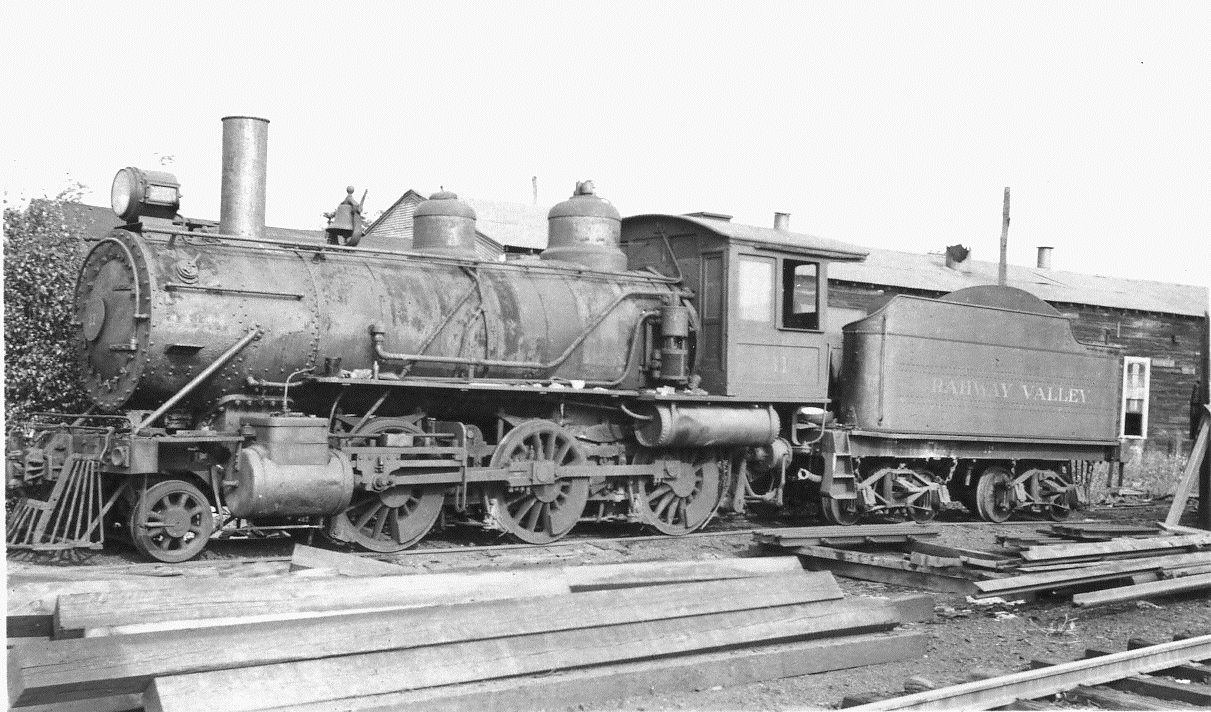 |
| #11, seen years
later in retirement, was purchased by the RV in
February, 1920. After #8 was rendered out of service in
1923, #11 handled all the RV's trains until the
purchasing of #12 in 1927. #11 was retired in 1933.
| |
As
part of England’s regime of getting the RV “back on track,” a
locomotive was acquired to supplement #8, 9, and 10, all of which had been well
worn by the rush of World War I. The newly acquired locomotive came
from the Grafton & Upton Railroad of Massachusetts, where it was
numbered #5, in February, 1920. Rahway Valley’s #11, a 2-6-0 Mogul, was a 1904
product of the Baldwin Locomotive Works. The two ex-PRR switchers
the RV owned, #9 and #10, were retired in 1920 and 1922,
respectively, and were eventually sold off. #9 and #10 eventually
saw service on the Seaboard
Air Line before being
retired in May, 1930. #8 and #11 remained to handle whatever
business remained along the rails of the Rahway Valley.
In
1919 England had a pamphlet published to entice industrial concerns
to locate their plants along the Rahway Valley Railroad. “The best
industrial sites near New York City are available on the Rahway
Valley Railroad, a belt line connecting and interchanging with all
the trunk lines, accessible to the best labor markets of Newark,
Orange, and Elizabeth, with a population of some 600,000, and also
with motor access on excellent asphalt macadam roads, only 14 miles
to New York City . . . Here the manufacturer may obtain a choice
from some 1,400 acres of land with the necessary railroad sidings .
. . The advantages of a location on such a route is obvious. A
manufacturer on a small road like the Rahway Valley, has the
advantage of the competition of all the trunk lines, so that empty
cars for quick loading and delivery may be obtained from either one
trunk line or the other on short notice, which facilities might not
be forthcoming on a busy line where there would be no competition to
spur the service” (England 808). England also listed the twenty-two
customers of the Rahway Valley at the time, which included coal and
lumber yards, two stone quarries, and two chemical companies, among
others.
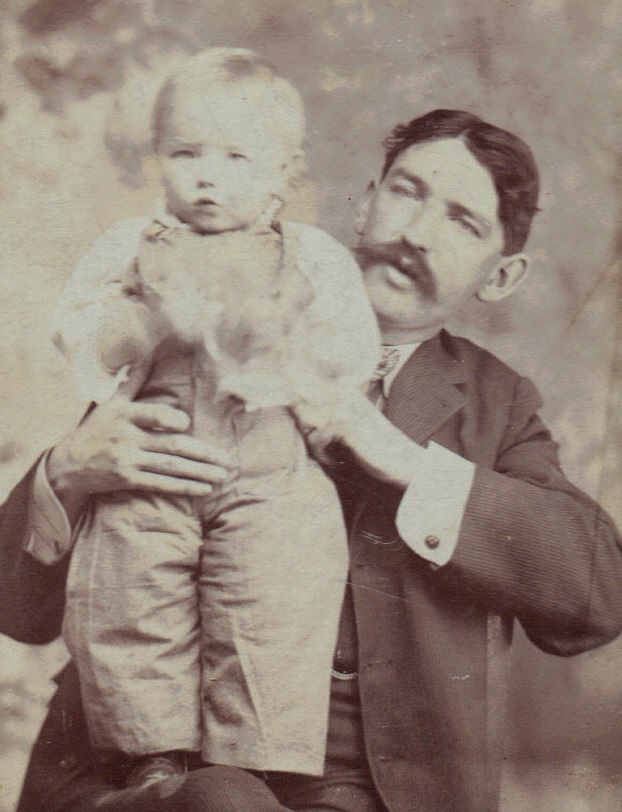 |
|
Roger
A. Clark and his young son George, while they still
lived in Rochester, NY. Collection of Carol
Clark
Holden. | |
The
railroad’s inept auditor, Andrew A. Lockwood, was
fired under England’s direction in early 1920. England enticed his
friend, Roger A.
Clark, to fill the position. "There were open fields along the tracks
when . . . Roger A. Clark, came to the Rahway Valley from Oregon in
1920. The thread of circumstance from which the Clarks' story
depends is that . . . [Roger A. Clark], who began railroading as a
traveling auditor on the Buffalo, Rochester, & Pittsburgh, was a
native of Rochester, N.Y. So was Robert H. England. . . Around
1909 England got R.A. Clark to go west as auditor of the Central
Railroad of Oregon . . . Later, R.A. became station agent at Boring,
Ore., for the Portland Railway, Light & Power interurban.
England, who had gone back east to become general manager of the
Rahway Valley, sent for R.A. to help him straighten out the books"
(Young
3).
Feeling his position was
only temporary; Clark came east to New Jersey and initially left his
wife and two children in Oregon pending his return, but the
situation at the Rahway Valley prompted something a bit more long
lasting, ". . . then R.A. decided to move the family to New Jersey
and take a permanent position with the Rahway Valley as auditor.
[His son,] George was hired too, as station agent at Springfield,
NJ. Soon afterward, England left the company, and R.A. was made
president and general manager" (Young
4).
England, not one to sit
still for long, had left the Rahway Valley to pursue other
railroading interests. "When R.A. Clark took over in 1920, with his
son as vice-president, general freight agent, and auditor, the RV
had about 20 customers - a few small manufacturers and a string of
coal and lumber yards. The three largest plants on the line had
closed after World War I. Some 1,400 acres of unoccupied industrial
land along its tracks were going begging. The movie producers who
used the line to make films with such early starts as Guy Coombs and
Anita Stewart had come and gone, and the passenger service, now
operated with railbuses, was on its last legs.” (Young
4).
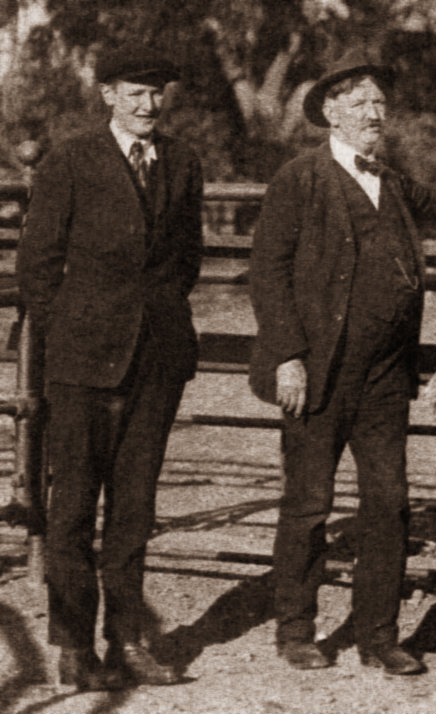 |
|
George
Clark with his dad Roger, on their way east to New
Jersey in 1920. Collection of Carol Clark
Holden. | |
"When the rest of the nation was
plunged into the depths of a depression, the matter of fact was the
RV actually began to make more money!” (Young).
Roger
Clark rekindled business ties with former customers of the railroad,
and things gradually started to pick up on the line. "Roger Clark, a railroader with much
experience in managing short-line railroads in the Pacific
Northwest. Arriving with his son, George Clark, he found upon taking
over as General Manager, the little pike was sadly neglected and in
default. As realistic men, the Clarks applied their hard-nosed
business experience to rebuilding the road and cultivating the
freight accounts" (McCoy
14). Clark siphoned revenue from anywhere he could
find
it. In addition to freight revenues, additional income came from the
leasing out of the Baltusrol Station (it became a post office
and later an office for Andrew Wilson, a DDT wholesaler) as well
as the Newark Heights Station. “Soliciting new business and reestablishing
old customers aggressively, the new management gradually moved the
balance sheet from red to black" (McCoy
14).
George Clark, Roger’s
son, recalled those early days “Plenty of times I went down to Trenton in those
days and got down on my knees to the tax men . . . We didn't know
from day to day if we were going to make it. We didn't even have the
money to meet our payroll when we started” (Cunningham
38-39
). Roger Clark’s “. . .
regime was marked by
wise and cautious handling of the road’s
business, such as it was, one of which was disposing of the useless
motor car” (Young). All vestiges of RV passenger service were
abolished during the mid-1920s.
Costs were cut wherever
they could be. The railroad used cinders for ballast, discarded railroad
ties as a means to retain fill at several
locations, and the facilities at Kenilworth received maintenance on
an as needed basis. “The repair
shed at Kenilworth, a long wooden structure, was so rickety that one
morning after a high wind the employees came to work to find it
leaning on the engines” (Young
4).
One thing the Clarks
couldn’t ignore, however, was their rag-tag fleet of steam
locomotive power. “The RV owned only one good locomotive” (Young
4) when the Clarks came east to manage the RV in 1920 and that
was #11. “The equipment includes two
engines, No.8, a ten wheel switch, weighing about 140,000 lbs. and
No.11, an eight wheel, light passenger type, weighing about 98,000
lbs. At present No.11 is doing all the work and No.8 is in the shed
at Kenilworth, having broken a set of springs about the first of
April” (Letter to E.E. Loomis from E.H. Boles). With just one
locomotive in service, the RV was in need of some new
equipment.
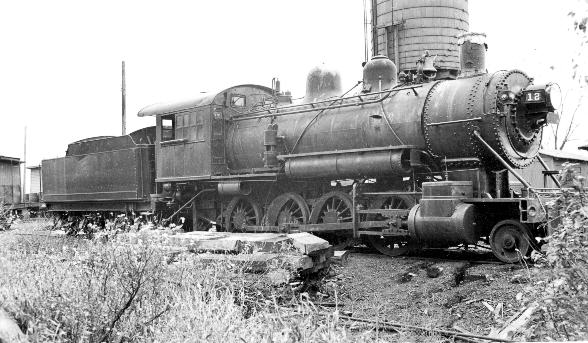 |
| #12, seen here in
dead storage in Kenilworth, proved too big for use on
the RV. Photo taken by George
Votava. | |
"The Clarks gradually replaced the
worn out locomotives with newer engines” (
McCoy 14
).
Over the span of three years, three locomotives were purchased.
“
Mr. Clark wisely reinvested in some much needed
equipment. In 1929 he scrapped the Engine Number Eight, along with a
pair of little 2-4-0s which had belonged to a hill excavating
company. This firm’s members had left town in a hurry, so he merely
cut up their engines to get the money they owed him” (Young). The
money Clark collected was spent on the purchases of #12, #13, and
#14.
The Rahway Valley’s #12, a 2-8-0 Consolidation
built by ALCo in August, 1902, came from the Bessemer & Lake
Erie Railroad (#96) in September of 1927. The locomotive only
remained in service on the RV for a short while, “No. 12 was the
heaviest engine on the road, too heavy for the 60 [lbs.] rail”
(Taber). Young tells us #12’s fate, “Number Twelve, a “too big”
2-8-0 which had been spreading the rails for two years, was retired,
permanently, when the Eight Spot was scrapped” (Young). The
locomotive remained in the yards at Kenilworth for the better part
of two decades before it was scrapped in 1943.
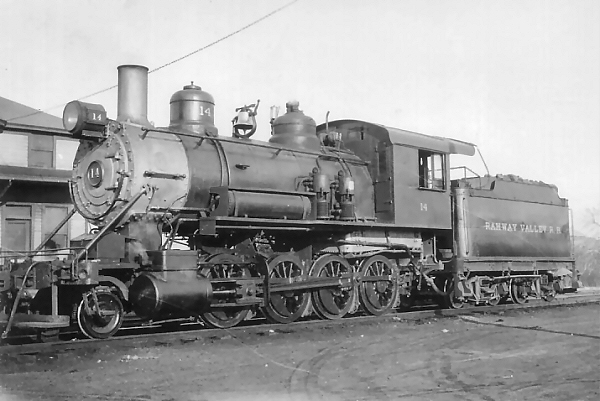 |
| #14, ex-Lehigh
& New England #20, was purchased by the RV in August
of 1928.
| |
With
#12’s purchase proving to be a fluke, Clark discerningly looked for
a locomotive more befitting the RV’s criteria. He found two. “In
place of them, [#8 and #12], came Numbers Thirteen and Fourteen from
the Lehigh and New England" (Young). The Rahway Valley’s #13 and #14, of the 2-8-0 Consolidation
type, were purchased from Georgia Car & Locomotive in May, 1928
and August, 1928, respectively. These two identical locomotives were
constructed by the Baldwin Locomotive Works in 1905 for the Lehigh
& New England Railroad as their #19 and #20. They
proved to be well worth the investment and served the RV nobly up
until the arrival of diesel power. #11 remained as standby
power.
Louis Keller, President
(RVRR) and longtime promoter of the Rahway Valley Railroad, had died
in Manhattan, NY on February 16, 1922. “. . . Mr. Keller passed away
leaving his relatives dubiously looking over their heritages, a flat
broke railroad, and a declining social magazine. In accordance with
his wishes, his money and holdings were put into an estate" (Young).
Keller left the majority of his $350,000 estate to his nephews,
Charles Keller Beekman and Louis
Lawrence; and his niece, Catherine Huger.
Beekman was charged with being the executor of his uncle’s estate.
Beekman, an attorney of the firm Beekman &
Bogue (a firm he founded with Morton Bogue), charged his
associate Ralph S. Wolcott with managing the estate. At the time of
his death, Keller held controlling interest in the Rahway Valley
Railroad.
Keller’s heirs,
as well as other RV shareholders, procured lawyers within the
firm of Beekm
an & Bogue to oversee their interests in the railroad.
Lawyers such as Ralph S. Wolcott, Hubert C.
Mandeville, and Louis Weeks, among others, would sit
on the RV’s Board of Directors and fill managerial spots. Of
Keller’s heirs only Louis Lawrence ever sat on the Board of
Directors. The law firm of Beekman & Bogue continued to have
oversight of the Rahway Valley Railroad for the remainder of its
independent common carrier years. Representatives within the firm
would periodically check-in on the day-to-day management at
Kenilworth (the Clarks) and yearly board meetings were held in the
Kenilworth Station. The shareholders of the railroad, and their
representatives within the firm of Beekman & Bogue, maintained a
“hands-off” policy and left the management of the railroad largely
to the Clarks.
.jpg) |
| #13 is seen here
along the rails of the Lackawanna in Summit, just four
short years after the connection was made. 1935.
Photo taken by Homer
Hill. | |
The greatest achievement of Roger
Clark’s term as the line’s chief managerial officer was the
establishment of a connection with the Lackawanna at Summit in 1931.
"At long last, in 1931, the Lackawanna, feeling the effects of the
Great Depression finally agreed to the long delayed connection with
the Rahway Valley. The switch was installed, and at last the
R.V.R.R. became a trunk line" (
McCoy 16
).
Roger Clark, and his son George, had entered into negotiations with
representatives of the Lackawanna just after the onset of the Great
Depression in 1929. The establishment of this connection at Summit
seemed to ensure the coming success of the Rahway Valley Railroad,
“. . . but when R.A. died in 1932 the RV's fortunes were again at
low ebb" (
Young 4
).
Roger A. Clark
died at his home on Morris Ave. in Union on October 3, 1932, he was
62. Clark’s career as a railroader had encompassed positions with
four railroad companies, the Buffalo, Rochester, and Pittsburgh of
New York; the Central Railroad of Oregon and Portland Railway both
of Oregon, and the Rahway Valley Railroad of New Jersey, and
included the saving of the latter. Clark’s later years were marred
by illness resulting from his diabetes. His illness resulted in the
amputation of his legs and his confinement to a wheel chair in his
later years. Despite his ailments, nothing could keep him from his
position as President and General Manager of the Rahway Valley
Railroad.
|